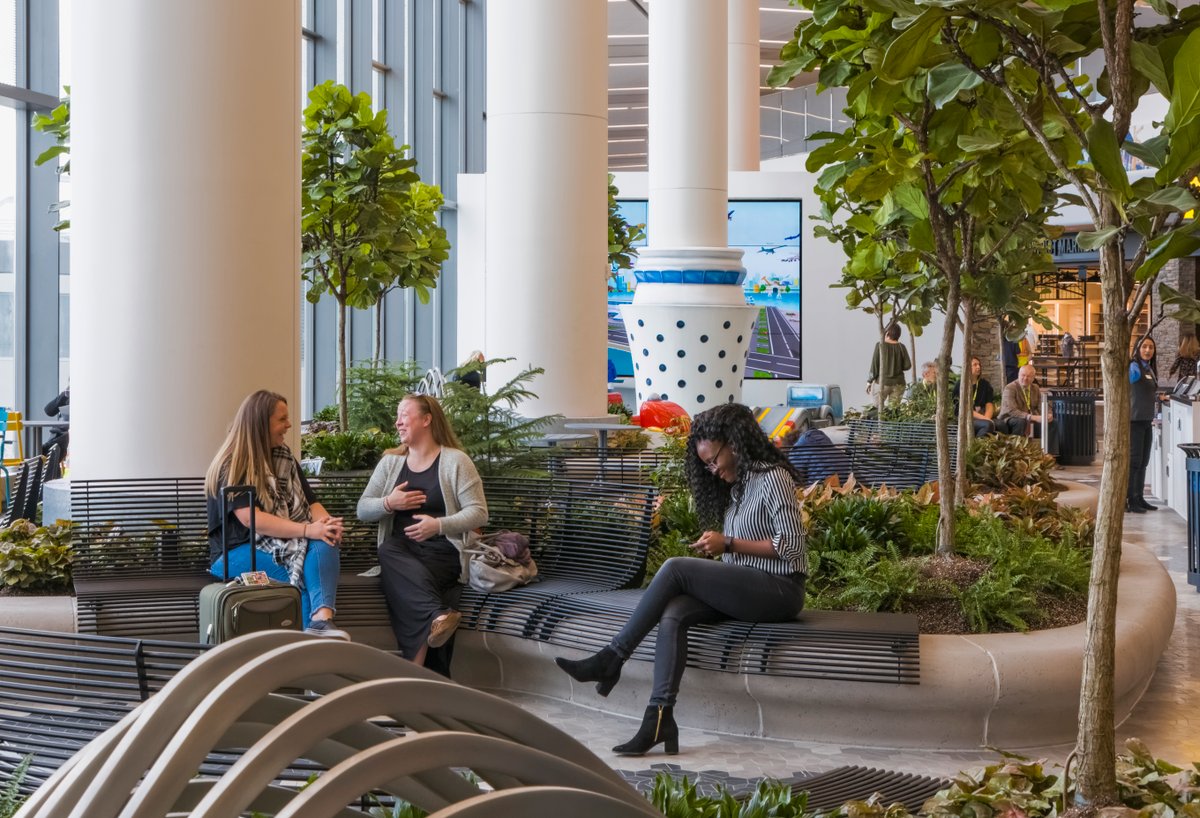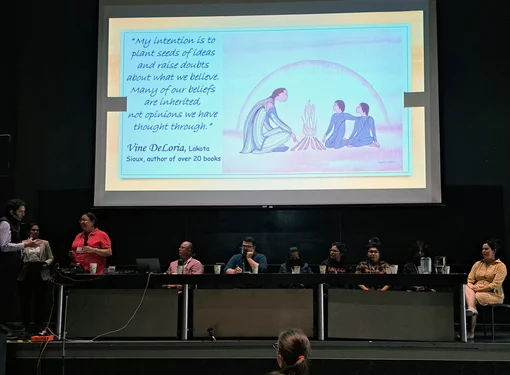LaGuardia Airport’s Terminal B Soars to America’s First RHFAC Gold
Le français suit l'anglais
The site of LaGuardia Airport has a long history. Before it was used as an aviation hub, serving more than 28 million passengers yearly, the lands were used for the Gala Amusement Park in the early 1900s, run by the Steinway family – founders of the famous Steinway and Sons piano company. The park was torn down in 1929 and made into the private Glenn H. Curtiss Airport.
New York mayor Fiorello La Guardia pushed to turn the airport into a hub for commercial flights. The New York Municipal Airport-LaGuardia Field, as it was then called, was dedicated on October 15, 1939. In 1947, after the Port of New York Authority took over control from the city, the name LaGuardia Airport was officially announced.
Complaining about Terminal B Became a Hobby for New Yorkers
By the early 2000s, complaining about LaGuardia -- specifically its Central Terminal Building, or Terminal B – was practically a hobby for New Yorkers, with good reason. The domestic terminal was run-down to the point passengers had to dodge buckets placed on the floor to catch rain leaking through the roof, ceilings were low, lighting was dingy and dim, and it was overcrowded. During a 2014 speech on infrastructure, then U.S. Vice-President Joe Biden called it “third world.”
“One of the more polite things anyone could say about the old Terminal B at LaGuardia Airport in New York is that it was the worst part of possibly the worst major airport in the world,” wrote Ben Cohen in his Wall Street Journal article "LaGuardia Airport is No Longer the Worst".
In 2015, the Port Authority of New York and New Jersey announced a comprehensive plan to construct a new LaGuardia Airport. The goal: creating a world-class passenger experience featuring modern customer amenities, state-of-the-art architecture, more spacious gate areas, and a unified terminal system. The $8 billion project broke ground in 2016, with Terminal B completed in 2022 (work is still underway on Terminal C).
And today, with the announcement of its Rick Hansen Foundation Accessibility Certification™ (RHFAC) Gold achievement, LaGuardia has once again made the history books.
LaGuardia Terminal B Makes Accessibility History
LaGuardia Gateway Partners (LGP) is the private manager and developer of LaGuardia Terminal B. They partnered with RHFAC to evaluate and provide accessibility recommendations.
RHFAC, a rating and recognition program that measures the meaningful accessibility of a site based on the holistic user experience of people with varying disabilities, has been utilized by more than 1,800 organizations in Canada, with approximately five percent of those earning RHFAC Gold – the highest level of accessibility in the program with a score of 80 percent or more.
LaGuardia’s Terminal B has not just created a historic milestone as the first location in the United States to achieve RHFAC Gold, but it is also showcasing its dedication to ensuring a welcoming environment for visitors of every age and ability.

In addition to the terminal’s lofty ceilings and generous infusion of natural light, LGP commissioned the Public Art Fund program to curate exceptional artwork within Terminal B. Throughout this process, the gorgeous design seamlessly incorporates accessibility features.
As part of being awarded RHFAC Gold, some of those accessibility features in LaGuardia’s Terminal B include:
- Hearing loops at all guest experience desks
- Intuitive departure board displays in two different formats and colour coding to assist with intuitive navigation. Distance to gates is also displayed
- Accessible assistance curbside drop-off/check-in service and call button
- Intuitive and consistent colour-coded wayfinding throughout the terminal, including the use of landmarks for intuitive navigation
- A calming NYC-style park seating area that is noticeably different from the rest of the Terminal’s spaces thanks to sensory stimulation provided through plants and foliage.

The RHFAC Gold announcement comes on the heels of other accolades. LaGuardia’s Terminal B was awarded the 2021 Prix Versailles (UNESCO’s annual architecture prize); the National Academy of Construction’s Special Achievement Award; NYC & Company Foundation’s “Visionaries and Voices” award; and awards from the Urban Land Institute New York and the Design-Build Institute of America.
Terminal B was also recently named the world’s best new terminal for 2023 by aviation ranking company Skytrax, as well as awarded their five-star designation.
Accessibility is Part of the Passenger Experience
The Gold rating affirms the commitment to accessibility by both the Port Authority of New York and New Jersey and LGP.
“Accessibility is a critical part of the Port Authority’s mission to create world-class airports where state- of-the-art technology and thoughtful design are making travel easier and less stressful for passengers of all ability levels,” said Port Authority Executive Director Rick Cotton.
“Among all the accolades received by Terminal B, we are particularly proud that the new terminal is the first in the nation to be awarded Gold certification by the Rick Hansen Foundation.”

Terminal B also offers the Hidden Disabilities Sunflower Lanyard to guests with disabilities that may not be easy to observe, such as autism, PTSD, and hearing loss. The lanyard identifies these guests and communicates that they may need assistance travelling through the terminal.
“Ensuring accessibility in public spaces is a crucial aspect of our commitment. We continue to explore ways to improve the accessibility of Terminal B and ensure that everyone can navigate the terminal with ease,” said Frank Scremin, CEO of LaGuardia Gateway Partners. “We’re proud our commitment to accessibility has received external recognition from the Rick Hansen Foundation.”

Accessibility is a Journey, not a Destination
The hallmark of accessibility is that it benefits all users. Good accessibility also tends to blend into the design. This is why those who find themselves in Terminal B at LaGuardia may seem a little thrown off by just how great the new space is after having experienced its previous incarnation.
As Cohen reported in his WSJ story, one of the LGP team members overheard the ultimate compliment when Terminal B opened: “I think we came to the wrong airport.”
While accessibility is a journey and not a destination, LaGuardia is on the right path to creating barrier-free travel experiences for everyone who moves through Terminal B.
“Accessible travel is a critical part of creating a world where we can all participate,” said Rick Hansen, Founder of the Rick Hansen Foundation. “Thank you for your commitment to helping to create a world where everyone can go everywhere.”
Le francais
L’aérogare B de l’aéroport LaGuardia est le premier organisme américain à se voir décerner la certification Or du Programme de certification en matière d’accessibilité de la Fondation Rick Hansen
UN TEXTE DE REBECCA BLISSET, 9 août 2023
Le site de l’aéroport LaGuardia a une longue histoire. Avant de devenir une plaque tournante de l’aviation qui accueille plus de 28 millions de passagers tous les ans, les terrains étaient utilisés pour le parc d’attractions Gala au début des années 1900. Le parc était exploité par la famille Steinway, fondatrice de la célèbre entreprise de fabrication de pianos Steinway and Sons. En 1929, on a démoli le parc qui est devenu l’aéroport privé Glenn H. Curtiss.
Le maire de New York Fiorello La Guardia a exercé des pressions pour transformer l’aéroport en une plaque tournante pour les vols commerciaux. Le New York Municipal Airport-LaGuardia Field, comme on l’appelait à l’époque, a été inauguré le 15 octobre 1939. En 1947, après que la Port of New York Authority eut pris la relève de la ville pour la l’exploitation de l’aéroport, le nom LaGuardia Airport a été officiellement annoncé.
Se plaindre de l’aérogare B, un passe-temps pour la population new-yorkaise
Au début des années 2000, se plaindre de LaGuardia – particulièrement de l’aérogare centrale, ou aérogare B – était pratiquement devenu un passe-temps pour la population new-yorkaise, et avec raison. Cette aérogare de trafic intérieur était délabrée au point où les passagères et passagers devaient éviter les seaux placés sur le plancher en vue de recueillir l’eau des pluies qui s’échappait du toit, les plafonds étaient bas, l’éclairage était blafard et elle était toujours bondée. En 2014, lors d’un discours sur les infrastructures, Joe Biden, alors vice-président des États-Unis, a qualifié l’aérogare de « tiers-mondiste ».
« Une des choses les plus polies qu’une personne pouvait dire à propos de l’ancienne aérogare B de l’aéroport LaGuardia à New York était qu’elle était la pire partie de ce qui était possiblement le pire des grands aéroports au monde », écrivait Ben Cohen dans un article du Wall Street Journal intitulé « LaGuardia Airport is No Longer the Worst » (L’aéroport LaGuardia n’est plus le pire).
En 2015, la Port Authority of New York and New Jersey a annoncé un plan exhaustif pour la construction d’un nouvel aéroport LaGuardia. Le but était de créer une expérience de classe mondiale pour les passagères et passagers, grâce à des commodités modernes pour la clientèle, une architecture ultramoderne, des aires plus spacieuses près des portes d’embarquement et un système d’aérogare unifié. Ce projet de huit milliards de dollars a démarré en 2016, et l’aérogare B a été achevée en 2022 (des travaux sont toujours en cours dans l’aérogare C).
Et aujourd’hui, avec l’annonce de l’obtention de la certification Or du Programme de certification en matière d’accessibilité de la Fondation Rick Hansen (RHFAC), LaGuardia est une fois de plus entré dans les livres d’histoire.
L’aérogare B de LaGuardia écrit une page de l’histoire de l’accessibilité
LaGuardia Gateway Partners (LGP) est le gestionnaire et le promoteur privé de l’aérogare B de LaGuardia. La société a travaillé en collaboration avec le Programme RHFAC qui a évalué l’aérogare et formulé des recommandations en matière d’accessibilité.
Le Programme RHFAC, un programme d’évaluation et de reconnaissance qui mesure l’impact de l’accessibilité d’un site sur la base de l’expérience holistique de personnes ayant divers handicaps, a été utilisé par plus de 1 800 organismes au Canada, dont environ cinq pour cent ont obtenu la certification Or, soit le plus haut niveau de certification en matière d’accessibilité du programme, avec une note 80 pour cent ou plus.
L’aérogare B de LaGuardia n’a pas seulement marqué un jalon historique comme premier site aux États-Unis à obtenir la certification Or du Programme RHFAC, mais elle a également fait la preuve de sa détermination à assurer un environnement accueillant pour les visiteuses et visiteurs de tous les âges et de toutes les capacités.

En plus des hauts plafonds de l’aérogare et de la profusion de lumière naturelle qui y pénètre, LGP a demandé au programme Public Art Fund de sélectionner des œuvres d’art exceptionnelles pour l’aérogare B. Tout au long de ce processus, des caractéristiques d’accessibilité ont été intégrées dans le superbe design.
Ci-dessous certaines des caractéristiques d’accessibilité de l’aérogare B de LaGuardia qui lui ont permis de recevoir la certification Or du Programme RHFAC :
- Des boucles auditives à tous les comptoirs dédiés à l’expérience clientèle
- Des tableaux d’affichage intuitifs au départ dans deux formats différents et munis d’un code couleur pour aider les gens à se repérer de façon intuitive. Les distances jusqu’aux portes d’embarquement sont également affichées.
- Un service d’aide pour le débarquement et l’enregistrement accessibles en bordure de trottoir ainsi qu’un bouton d’appel
- Un système d’orientation intuitif et cohérent, avec un code couleur dans l’ensemble de l’aérogare, y compris l’utilisation de repères pour permettre aux gens de se déplacer de façon intuitive
- Une aire de places assises qui se présente sous la forme d’un parc apaisant de style new-yorkais qui se distingue nettement des autres espaces de l’aérogare grâce à la stimulation sensorielle apportée par des plantes et du feuillage.

L’annonce de la certification Or du Programme RHFAC fait suite à d’autres distinctions qu’a reçues l’aérogare B de LaGuardia. En effet, l’aérogare B a reçu, en 2021, le Prix Versailles (le prix annuel d’architecture de l’UNESCO) ; le Special Achievement Award de la National Academy of Construction ; le prix « Visionaries and Voices » de la NYC & Company Foundation ; ainsi que des prix de l’Urban Land Institute New York et du Design-Build Institute of America.
Par ailleurs, l’aérogare B a récemment été nommée meilleure nouvelle aérogare au monde de 2023 par Skytrax, un organisme de notation du transport aérien, qui lui a décerné la désignation cinq étoiles.
L’accessibilité fait partie de l’expérience des passagères et passagers
Cette certification Or affirme l’engagement à l’égard de l’accessibilité de la Port Authority of New York and New Jersey et de LGP.
« L’accessibilité est un élément essentiel de la mission la Port Authority qui est de créer des aéroports de calibre mondial qui rendent les voyages plus faciles et moins stressants pour les personnes de toutes les capacités, grâce à une technologie de pointe et une conception réfléchie », indique le directeur général de la Port Authority Rick Cotton.
« Parmi tous les prix reçus par l’aérogare B, nous sommes particulièrement fiers que cette nouvelle aérogare soit la première du pays à avoir obtenu la certification Or de la Fondation Rick Hansen. »

L’aérogare B offre également les cordons « tournesol » pour les personnes ayant un handicap difficile à déceler, comme l’autisme, le syndrome de stress post-traumatique et la perte auditive. Les cordons identifient ces personnes et indiquent qu’elles pourraient avoir besoin d’aide pour se déplacer dans l’aérogare.
« Assurer l’accessibilité dans les endroits publics est un aspect crucial de notre engagement. Nous continuons d’explorer des façons d’améliorer l’accessibilité de l’aérogare B tout en faisant en sorte que tout le monde puisse s’y déplacer facilement », affirme Frank Scremin, président-directeur général de LaGuardia Gateway Partners. « Nous sommes fiers que notre engagement à l’égard de l’accessibilité nous ait valu la reconnaissance d’un organisme externe, la Fondation Rick Hansen. »

L’accessibilité, c’est un parcours et non une destination
La particularité de l’accessibilité est qu’elle profite à toutes les utilisatrices et tous les utilisateurs. En général, une bonne accessibilité s’intègre dans la conception. C’est pourquoi toutes les personnes qui se trouvent dans l’aérogare B de LaGuardia peuvent sembler un peu déconcertées par la grandeur du nouvel espace après en avoir expérimenté l’incarnation précédente.
Comme l’a raconté Cohen dans son article du Wall Street Journal, un des membres de l’équipe de LGP a entendu ce compliment ultime à l’ouverture de l’aérogare : « Je pense que nous nous sommes trompés d’aéroport ».
L’accessibilité, c’est un parcours et non une destination, et LaGuardia est en bonne voie de créer des expériences exemptes d’obstacles pour toutes les personnes qui déplacent dans l’aérogare B.
« Les voyages accessibles font partie intégrante de l’édification d’un monde dans lequel nous pouvons toutes et tous participer », affirme Rick Hansen, fondateur de la Fondation Rick Hansen. « Merci de votre engagement à contribuer à l’édification d’un monde dans lequel tout le monde peut aller partout. »






